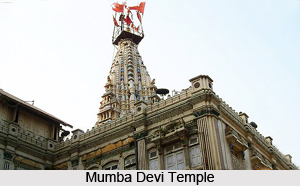 Mumba Devi temple is revered, as the Shakti temple in Mumbai, holding much importance, since its presiding Goddess Mumbadevi, is also the patron goddess of the city. In fact, the name of the city, Mumbai, has been derived from Maa Mumbadevi. The Mumba Devi temple once stood on the site of the present Voctoria Terminus in the central that was called Mumbai.
Mumba Devi temple is revered, as the Shakti temple in Mumbai, holding much importance, since its presiding Goddess Mumbadevi, is also the patron goddess of the city. In fact, the name of the city, Mumbai, has been derived from Maa Mumbadevi. The Mumba Devi temple once stood on the site of the present Voctoria Terminus in the central that was called Mumbai.
The local Koli (fishermen) constructed it around the 14th or 15th century, in honour of Mumbadevi, (the first Mumbadevi temple was built at Bori Bunder) which was later demolished and rebuilt in 1737 at Bhuleshwar. The legend goes that Mumbadevi (in the form of an eight-armed goddess) was sent by Lord Brahma to slay a wicked demon, Mumbaraka, who harassed and derived great pleasure out of tormenting the local population. Thus defeated Mumbaraka pleaded with the goddess to have his name and later built a temple in her honour. She, thus still stands there, an orange-faced goddess on an altar full of marigolds.
At first sight Mumba Devi temple does not look as striking as the rest of the temples in the city. However, at a closer glance, we can find an intrinsic beauty attached to it, due to the faith and reverence that Mumbaikers pay to their goddess. The structure is about six centuries old. The modern shrine contains an image of the Goddess Mumbadevi dressed in a robe with a silver crown, a nose ring and a golden necklace. To the left is a stone figure of Annapurna seated on a peacock, in front of the deity, is a tiger, the carrier of the goddess. Idols of Indra, Ganesh and Hanuman can also be found. Mumba is a goddess without a mouth and is a local representation of the Mother Earth. It is a general belief that the goddess never disappoints their devotees if he/she prays sincerely. Mumba Devi temple is open on all days, except Mondays.
Mumba Devi temple is located at one of the most crowded market/business areas in Mumbai, known as Bhuleshwar. It is 10 minutes walkable distance from Charni Road Station (East), or alternately one can take a taxi from some other stations like Churchgate, Marine Drive. One can also visit the nearby places like Zaveri bazaar (famous for its jewellery wares), Princess Street, Bhuleshwar market for ornaments in every occasion, C P tank market and Crawford market.





















